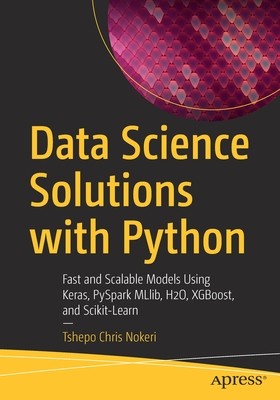
- We will send in 10–14 business days.
- Author: Tshepo Chris Nokeri
- Publisher: Apress
- ISBN-10: 1484277619
- ISBN-13: 9781484277614
- Format: 17.8 x 25.4 x 0.7 cm, softcover
- Language: English
- SAVE -10% with code: EXTRA
Reviews
Description
Chapter 1: Understanding Machine Learning and Deep Learning.
Chapter goal: It carefully presents supervised and unsupervised ML and DL models and their application in the real world.
Understanding Machine Learning.
Supervised Learning.
The Non-parametric method.
Ensemble Methods.
- Unsupervised Learning.
Cluster Analysis.
Dimension Reduction.
- Exploring Deep Learning.
Conclusion.
The Parametric Method.
Chapter goal: It explains a big data framework recognized as PySpark, machine learning frameworks like SciKit-Learn, XGBoost, and H2O, and a deep learning framework called Keras.
Big Data Frameworks and ML and DL Frameworks.
Characteristics of Big Data.
Impact of Big Data on Business and People.
Refined Product Development.
Improved Decision-Making.
- Big Data Warehousing.
Big Data ETL.
Big Data Frameworks.
Resilient Distributed Datasets.
Spark Configuration.
- Spark Frameworks.
ML Frameworks.
SciKit-Learn.
- H2O.
XGBoost.
Big Data.
Better Customer Relationships.
Apache Spark.
DL Frameworks.
Keras.
Conclusion.
Chapter 3: The Parametric Method - Linear Regression.
Chapter goal: It considers the most popular parametric model - the Generalized Linear Model.
Regression Analysis.
SciKit-Learn in action.
Spark MLlib in action.
- H2O in action.
Conclusion.
Regression in practice.
Chapter goal: It covers two main survival regression analysis models, the Cox Proportional Hazards and Accelerated Failure Time model.
Cox Proportional Hazards.
Lifeline in action.
Spark MLlib in Action.
Conclusion.
Chapter 5: The Non-Parametric Method - Classification.
Chapter goal: It covers a binary classification model, recognized as Logistic Regression, using SciKit-Learn, Keras, PySpark MLlib, and H2O.
Logistic Regression.
SciKit-Learn in action.
Spark MLlib in Action.
- H2O in action.
Conclusion.
Chapter goal: It covers two main ensemble methods, the decision tree model and the gradient boost model.
Decision Tree.
SciKit-Learn in action.
Gradient Boosting.
XGBoost in action.
H2O in action.
Spark MLlib in Action.
Conclusion.
Chapter 7: Artificial Neural Networks.
Chapter goal: It covers deep learning and its application in the real world. It shows ways of designing, building, and testing an MLP classifier using the SciKit-Learn framework and an artificial neural network using the Keras framework.
Deep Learning.
Restricted Boltzmann Machine.
Multi-Layer Perception Neural Network.
SciKit-Learn in action.
Keras in action.
H2O in action.
Deep Belief Networks.
Chapter 8: Cluster Analysis using K-Means.
Chapter goal: It covers a technique of finding k, modelling and evaluating a cluster model known as K-Means using frameworkEXTRA 10 % discount with code: EXTRA
The promotion ends in 18d.06:41:33
The discount code is valid when purchasing from 10 €. Discounts do not stack.
- Author: Tshepo Chris Nokeri
- Publisher: Apress
- ISBN-10: 1484277619
- ISBN-13: 9781484277614
- Format: 17.8 x 25.4 x 0.7 cm, softcover
- Language: English English
Chapter 1: Understanding Machine Learning and Deep Learning.
Chapter goal: It carefully presents supervised and unsupervised ML and DL models and their application in the real world.
Understanding Machine Learning.
Supervised Learning.
The Non-parametric method.
Ensemble Methods.
- Unsupervised Learning.
Cluster Analysis.
Dimension Reduction.
- Exploring Deep Learning.
Conclusion.
The Parametric Method.
Chapter goal: It explains a big data framework recognized as PySpark, machine learning frameworks like SciKit-Learn, XGBoost, and H2O, and a deep learning framework called Keras.
Big Data Frameworks and ML and DL Frameworks.
Characteristics of Big Data.
Impact of Big Data on Business and People.
Refined Product Development.
Improved Decision-Making.
- Big Data Warehousing.
Big Data ETL.
Big Data Frameworks.
Resilient Distributed Datasets.
Spark Configuration.
- Spark Frameworks.
ML Frameworks.
SciKit-Learn.
- H2O.
XGBoost.
Big Data.
Better Customer Relationships.
Apache Spark.
DL Frameworks.
Keras.
Conclusion.
Chapter 3: The Parametric Method - Linear Regression.
Chapter goal: It considers the most popular parametric model - the Generalized Linear Model.
Regression Analysis.
SciKit-Learn in action.
Spark MLlib in action.
- H2O in action.
Conclusion.
Regression in practice.
Chapter goal: It covers two main survival regression analysis models, the Cox Proportional Hazards and Accelerated Failure Time model.
Cox Proportional Hazards.
Lifeline in action.
Spark MLlib in Action.
Conclusion.
Chapter 5: The Non-Parametric Method - Classification.
Chapter goal: It covers a binary classification model, recognized as Logistic Regression, using SciKit-Learn, Keras, PySpark MLlib, and H2O.
Logistic Regression.
SciKit-Learn in action.
Spark MLlib in Action.
- H2O in action.
Conclusion.
Chapter goal: It covers two main ensemble methods, the decision tree model and the gradient boost model.
Decision Tree.
SciKit-Learn in action.
Gradient Boosting.
XGBoost in action.
H2O in action.
Spark MLlib in Action.
Conclusion.
Chapter 7: Artificial Neural Networks.
Chapter goal: It covers deep learning and its application in the real world. It shows ways of designing, building, and testing an MLP classifier using the SciKit-Learn framework and an artificial neural network using the Keras framework.
Deep Learning.
Restricted Boltzmann Machine.
Multi-Layer Perception Neural Network.
SciKit-Learn in action.
Keras in action.
H2O in action.
Deep Belief Networks.
Chapter 8: Cluster Analysis using K-Means.
Chapter goal: It covers a technique of finding k, modelling and evaluating a cluster model known as K-Means using framework

Reviews